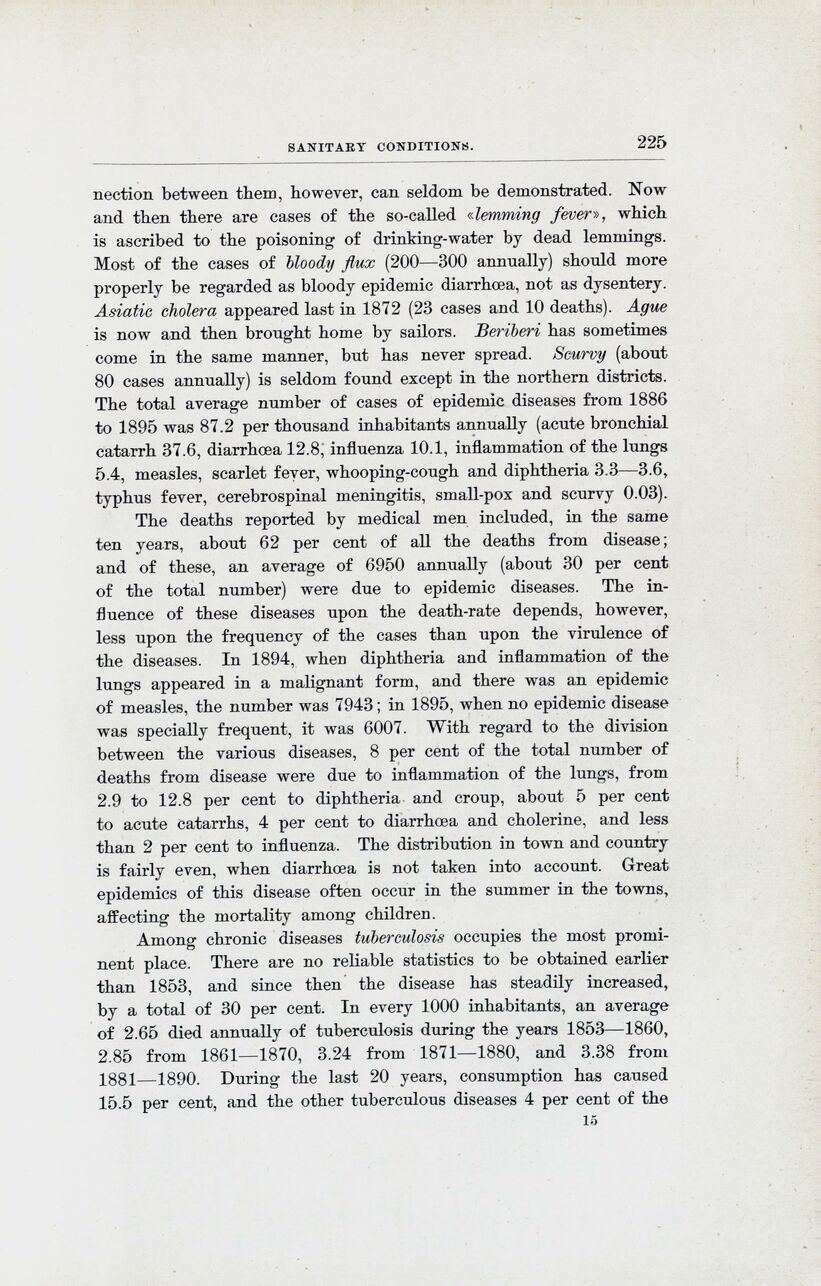
Full resolution (JPEG) - On this page / på denna sida - Sanitary Conditions, by Wilhelm Hiorth

<< prev. page << föreg. sida << >> nästa sida >> next page >>
Below is the raw OCR text
from the above scanned image.
Do you see an error? Proofread the page now!
Här nedan syns maskintolkade texten från faksimilbilden ovan.
Ser du något fel? Korrekturläs sidan nu!
This page has been proofread at least once.
(diff)
(history)
Denna sida har korrekturlästs minst en gång.
(skillnad)
(historik)
connection between them, however, can seldom be demonstrated. Now
and then there are cases of the so-called «lemming fever», which
is ascribed to the poisoning of drinking-water by dead lemmings.
Most of the cases of bloody flux (200—300 annually) should more
properly be regarded as bloody epidemic diarrhœa, not as dysentery.
Asiatic cholera appeared last in 1872 (23 cases and 10 deaths). Ague
is now and then brought home by sailors. Beriberi has sometimes
come in the same manner, but has never spread. Scurvy (about
80 cases annually) is seldom found except in the northern districts.
The total average number of cases of epidemic diseases from 1886
to 1895 was 87.2 per thousand inhabitants annually (acute bronchial
catarrh 37.6, diarrhœa 12.8, influenza 10.1, inflammation of the lungs
5.4, measles, scarlet fever, whooping-cough and diphtheria 3.3—3.6,
typhus fever, cerebrospinal meningitis, small-pox and scurvy 0.03).
The deaths reported by medical men included, in the same
ten years, about 62 per cent of all the deaths from disease;
and of these, an average of 6950 annually (about 30 per cent
of the total number) were due to epidemic diseases. The
influence of these diseases upon the death-rate depends, however,
less upon the frequency of the cases than upon the virulence of
the diseases. In 1894, when diphtheria and inflammation of the
lungs appeared in a malignant form, and there was an epidemic
of measles, the number was 7943; in 1895, when no epidemic disease
was specially frequent, it was 6007. With regard to the division
between the various diseases, 8 per cent of the total number of
deaths from disease were due to inflammation of the lungs, from
2.9 to 12.8 per cent to diphtheria and croup, about 5 per cent
to acute catarrhs, 4 per cent to diarrhœa and cholerine, and less
than 2 per cent to influenza. The distribution in town and country
is fairly even, when diarrhœa is not taken into account. Great
epidemics of this disease often occur in the summer in the towns,
affecting the mortality among children.
Among chronic diseases tuberculosis occupies the most
prominent place. There are no reliable statistics to be obtained earlier
than 1853, and since then the disease has steadily increased,
by a total of 30 per cent. In every 1000 inhabitants, an average
of 2.65 died annually of tuberculosis during the years 1853—1860,
2.85 from 1861—1870, 3.24 from 1871—1880, and 3.38 from
1881—1890. During the last 20 years, consumption has caused
15.5 per cent, and the other tuberculous diseases 4 per cent of the
<< prev. page << föreg. sida << >> nästa sida >> next page >>